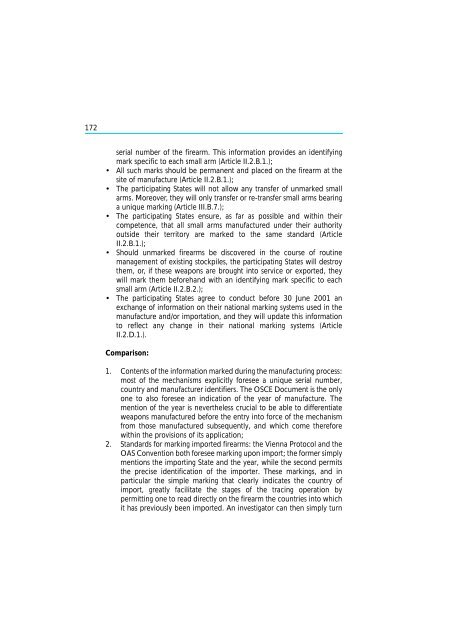The Scope and Implications of a Tracing Mechanism for Small Arms ...
The Scope and Implications of a Tracing Mechanism for Small Arms ...
The Scope and Implications of a Tracing Mechanism for Small Arms ...
You also want an ePaper? Increase the reach of your titles
YUMPU automatically turns print PDFs into web optimized ePapers that Google loves.
172<br />
serial number <strong>of</strong> the firearm. This in<strong>for</strong>mation provides an identifying<br />
mark specific to each small arm (Article II.2.B.1.);<br />
• All such marks should be permanent <strong>and</strong> placed on the firearm at the<br />
site <strong>of</strong> manufacture (Article II.2.B.1.);<br />
• <strong>The</strong> participating States will not allow any transfer <strong>of</strong> unmarked small<br />
arms. Moreover, they will only transfer or re-transfer small arms bearing<br />
a unique marking (Article III.B.7.);<br />
• <strong>The</strong> participating States ensure, as far as possible <strong>and</strong> within their<br />
competence, that all small arms manufactured under their authority<br />
outside their territory are marked to the same st<strong>and</strong>ard (Article<br />
II.2.B.1.);<br />
• Should unmarked firearms be discovered in the course <strong>of</strong> routine<br />
management <strong>of</strong> existing stockpiles, the participating States will destroy<br />
them, or, if these weapons are brought into service or exported, they<br />
will mark them be<strong>for</strong>eh<strong>and</strong> with an identifying mark specific to each<br />
small arm (Article II.2.B.2.);<br />
• <strong>The</strong> participating States agree to conduct be<strong>for</strong>e 30 June 2001 an<br />
exchange <strong>of</strong> in<strong>for</strong>mation on their national marking systems used in the<br />
manufacture <strong>and</strong>/or importation, <strong>and</strong> they will update this in<strong>for</strong>mation<br />
to reflect any change in their national marking systems (Article<br />
II.2.D.1.).<br />
Comparison:<br />
1. Contents <strong>of</strong> the in<strong>for</strong>mation marked during the manufacturing process:<br />
most <strong>of</strong> the mechanisms explicitly <strong>for</strong>esee a unique serial number,<br />
country <strong>and</strong> manufacturer identifiers. <strong>The</strong> OSCE Document is the only<br />
one to also <strong>for</strong>esee an indication <strong>of</strong> the year <strong>of</strong> manufacture. <strong>The</strong><br />
mention <strong>of</strong> the year is nevertheless crucial to be able to differentiate<br />
weapons manufactured be<strong>for</strong>e the entry into <strong>for</strong>ce <strong>of</strong> the mechanism<br />
from those manufactured subsequently, <strong>and</strong> which come there<strong>for</strong>e<br />
within the provisions <strong>of</strong> its application;<br />
2. St<strong>and</strong>ards <strong>for</strong> marking imported firearms: the Vienna Protocol <strong>and</strong> the<br />
OAS Convention both <strong>for</strong>esee marking upon import; the <strong>for</strong>mer simply<br />
mentions the importing State <strong>and</strong> the year, while the second permits<br />
the precise identification <strong>of</strong> the importer. <strong>The</strong>se markings, <strong>and</strong> in<br />
particular the simple marking that clearly indicates the country <strong>of</strong><br />
import, greatly facilitate the stages <strong>of</strong> the tracing operation by<br />
permitting one to read directly on the firearm the countries into which<br />
it has previously been imported. An investigator can then simply turn
















